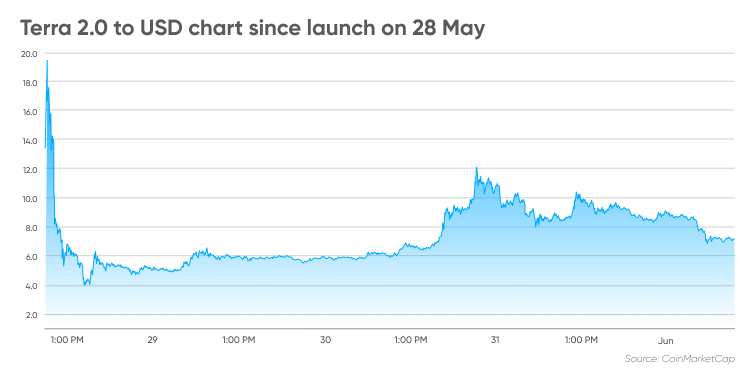What is Terra Luna 2.0? Everything you need to know about Terra’s fork

The Terra ecosystem launched a new chain on 28 May 2022. The new coin, Terra (LUNA) or LUNA 2.0, started trading at $17.80, briefly spiking to $19.53 within the first hour of trading. It wasn’t long until those prices were proven unsustainable. The old chain, Terra Classic, coexists with LUNA 2.0, and currently has a larger market cap of around $961m. Terra (LUNA) has a market cap of around £201m.
The Binance, KuCoin and OKX cryptocurrency exchanges listed the new Luna 2.0 token (LUNA) on their platforms earlier on in the year, but the coin continued to underperform, largely trading sideways between $1.50 and $2 in the following months, with the exception of a rally of about 200% on 9 September.
However, following the issuance of an arrest warrant for Terra co-founder Do Kwon by a South Korean court later that month, Terra Classic (LUNC) crashed to $0.000291, down over 20%, while LUNA crashed 40%.
Terra Luna was in no way immune to the fallout from the FTX scandal, and the coin hit an all-time low of $1.44 on 22 November.
As of 29 November 2022, Terra (LUNA) was trading at $1.58, while Terra Classic (LUNC) was worth $0.0001606.
Terra Luna’s revival plan
Previously, the Terra Luna community approved a revival plan that involves a Terra Luna hard fork from the failed token, the creation of a new blockchain Terra 2.0 and a new token.
LUNA’s crash made headlines back in May, sending shockwaves through the wider cryptocurrency space, with bitcoin (BTC) and ether (ETH) crumbling and cryptocurrency trading platform Binance (BNB) forced to suspend trading. The old LUNA coin was part of a dual-token system along with Terra’s US dollar-pegged stablecoin Terra USD (UST).
Terra USD is an algorithmic stablecoin, which means that its peg to the US dollar was ensured by algorithms and game theory, using a series of smart contracts to keep the price at $1.
When UST depegged from the US dollar (USD) on 9 May, UST redemptions massively inflated LUNA supply, driving the price down by 99%. The UST crash happened as the algorithms could not keep up, forcing the Luna Foundation Guard and its governance team to sell their bitcoin reserves to save the stablecoin.
BTC dropped to $27,000 and wiped out nearly $400bn of the total cryptocurrency market value over the May period.
What is LUNA 2.0?
As proposed by Kwon, the Terra blockchain underwent a hard fork, with the launch of Terra 2.0 and the old LUNA tokens being renamed as terra classic (LUNC). Kwon’s fork proposal passed with 65.5% majority approval.
The snapshot for Terra 2.0 provided by Kwon gives an idea of how the chain upgrade would work and states that the new Terra will be created without the algorithmic stablecoin.
The Terra Builders Alliance has provided technical details on integration, decentralised applications (dApps) migration, and a guide to rebranding the original Terra chain as ‘Terra Classic’.
The old token was renamed terra classic (LUNC), and while the original Cosmos chain will continue to operate, the option to mint or burn coins will be disabled. The new blockchain was launched on 28 May 2022.
1/ Yesterday, we said Terra 2.0 is coming. Tomorrow, it arrives.
— Terra ???? Powered by LUNA ???? (@terra_money) 27 May 2022
The community has been working around the clock to coordinate the new chain’s launch. Subject to potential change, we expect Terra to go live on May 28th, 2022 at around 06:00 AM UTC.
Terra Station, Terra Finder, the project’s block explorer, and Terra Observer, the project’s feeder for dApps, will all have full functionality under the new network, according to Terra’s team.
How does LUNA Classic work?
What is terra luna classic (LUNC)? It’s simply a new name for the failed LUNA coins, which are being replaced by the new LUNA coins on the Terra 2.0 blockchain.
They were first airdropped to UST and LUNA holders from 28 May, according to Terra’s Twitter.
10/ Q: When will the airdrop occur?
— Terra ???? Powered by LUNA ???? (@terra_money) 27 May 2022
A: The LUNA airdrop will occur on the first block of the new Terra chain, expected on or around May 28th, 2022 at 06:00:00 GMT.
There are predetermined groups that are receiving airdrops of the new LUNA coins:
Community pool is receiving 30% of the token distribution, with 10% earmarked for developers.
Pre-crash or pre-attack LUNA holders are receiving 35% of the new LUNA tokens.
Pre-crash UST holders are receiving 10% of the new tokens.
Post-crash LUNA holders are receiving 10% of the new tokens, including staking derivatives – 30% of the tokens are being unlocked at genesis, with the remaining 70% vested over two years, with a six-month cliff.
Post-crash UST holders are receiving 15% of the tokens – 30% of those are unlocked at genesis, and 70% will be vested over two years, with a six-month cliff.
Terra airdropped the new coins to all holders with at least 10,000 of LUNA tokens or less “to ensure that small luna holders have similar initial liquidity profiles”.
The governance also removed Terraform Labs’ (TFL) wallet from the whitelist for the airdrop, to make Terra a fully community-owned chain. Additionally, a large portion of the token was allocated to Terra dApp developers to make the ecosystem successful in the long run and provide network security.
Binance, OKX and KuCoin list new LUNA tokens
While the airdrop boosted the new token to as high as $19.53 after Terra’s core release, the coin quickly slumped to a low of $3.93 and was trading between $4 and $7 before the Binance listing, which pushed Terra 2.0 coin to as high as $11.97.
Binance, the world’s biggest cryptocurrency exchange, listed the new Luna 2.0 token in its Innovation Zone back in May. The Innovation Zone is a space for more experienced and risk-tolerant traders to get exposure to new token offerings and innovative projects.
The OKX and KuCoin cryptocurrency exchanges also listed the new LUNA coin. Both supported Terra’s airdrop of the new tokens in line with Binance.

The token however, continued to slump, losing 40% of its value from the post-listings peak, as airdrop receivers report selling off their new tokens to make up for losses during the UST and LUNA crash.
Zero plans to buy $luna 2.0, but I will dump any airdrop if I get something on Binance.
— Lark Davis (@TheCryptoLark) 29 May 2022
In light of the latest LUNA 2.0 news, a rally on 9 September 2022 ignited a speculative frenzy, which saw gains of over 200% and a massive spike in trading volume. However, allegations of fraud against Terraform Labs were made following the May collapse, when $40bn was wiped off the value of Terra.
The South Korean courts have also issued an arrest for Do Kwon, for allegedly violating capital market rules after the multi-billion-dollar implosion.
Terra 2.0 forecast
The future of Terra (LUNA) depends on its rebrand and launch. With the community’s support for Terra’s fork, the team initially seemed to be on a healthy recovery path.
As the new LUNA coin is still extremely unstable, it is extremely difficult to forecast its further direction. As of 29 November 2022, algorithm-based forecasting service PricePrediction suggested that the new coin will average $2.36 in 2023, rising to an average of $4.83 in 2025, and an average of $32.54 by 2030.
However, these predictions are based on algorithms and do not consider the current scenario. From FTX scandals to rebranding attempts and saving the crypto community’s trust, will depend on how the revival plan plays out.
Anndy Lian, chairman of the Netherlands-registered crypto trading platform BigONE Exchange, said that Terra’s community remains strong, yet he’s uncertain for how long.
“They are willing to make changes on their own. Some of them even go to the extent of sending their own wallet to the burn address to help reduce the supply. This is the kind of commitment you see on the ground,” he told Capital.com in a note.
“But such moves by the community are temporary and will not last long, given that the core issues are not resolved. They have to clearly state how the funds were being managed, who was and is involved in the whole process.”
Lian believes that in order for Terra Luna’s fork to work, the project needs trust and transparency, which would ensure an upbeat outlook and speedy growth.
“Many people out in the market are just concerned about the price. The truth is no matter what the price is and how the fork is going to turn out, the more immediate thing to do is to stabilise the projects in their current ecosystem, let them migrate their dApps and apps to the new blockchain so that they do not have any downtime,” Lian added.
Note that price predictions can be wrong and shouldn’t be used as a substitute for your own research. You should always conduct your own due diligence. Keep in mind that cryptocurrencies are extremely volatile, and never invest or trade money you cannot afford to lose.
FAQs
Is Terra LUNA 2.0 a good investment?
Whether the new LUNA coin is a suitable investment for you depends on your risk tolerance, portfolio size and goals, and experience in cryptocurrency markets. Remember to always do your own research before any investing or trading decision, and never invest or trade money you cannot afford to lose.
What happens to old LUNA tokens?
As Terra has undergone a hard fork, the old LUNA coins have been rebranded as luna classic, trading under the ticker LUNC. Some former LUNA and UST holders received a portion of the new LUNA 2.0 token airdrop.
When will LUNA 2.0 be released?
As per the Terra Ecosystem Revival Plan 2, Terra LUNA 2.0 was airdropped on 28 May 2022.
How to get Terra 2.0 (Luna 2.0) tokens
The first new LUNA coins were airdropped to pre-crash and post-crash LUNA and UST holders and the developer community on 28 May 2022.
Markets in this article
Related topics
